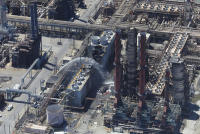Chevron: Safety oversights, poor record keeping contributed to massive Richmond refinery blaze
By Robert Rogers
Contra Costa Times
Posted: 04/12/2013 12:49:33 PM PDT
Updated: 04/12/2013 10:05:51 PM PDT
Click photo to enlarge

Firefighting crews continue to pour water onto a unit after a fire at a Chevron refinery on...
Related
RICHMOND -- In an 80-page report released Friday on its own investigation into last summer's massive refinery fire, Chevron U.S.A. Inc. acknowledged its failure to identify and replace a corroded pipe and vowed to take steps to prevent a similar accident from happening again.
The oil giant also acknowledged that it mishandled its response to the pipe leak that sparked the blaze.
The report, submitted to the Contra Costa Health Services department and released to the media Friday morning, arrived at many of the same general findings as the U.S. Chemical Safety Board, one of the agencies investigating the Aug. 6 fire that sent more than 15,000 people to area hospitals and shut down the heart of the refinery for months.
The safety board said in a public meeting April 5 that Chevron missed multiple opportunities to replace the pipe blamed for the blaze.
Chevron's own investigation revealed four "causal factors" that triggered the fire, which injured several workers and sent more than 15,000 people to area hospitals. The four factors were:
· Once a pipe leak was discovered, workers did not "recognize the risk of piping rupture and the possibility of auto-ignition." As a result, workers may have worsened the leak by removing the aluminum weather jacketing from the pipe and using firefighting equipment to remove the pipe insulation.
· A 2002 discovery of significant thinning to the pipe that later ruptured was buried in a software database, limiting the "ability for future decision makers to utilize the data."
· Inspectors failed to grasp the importance of inspecting carbon steel components vulnerable to corrosion.
· A 2011 component inspection was incomplete, passing over the pipe that ruptured a year later. The inspection could have alerted officials that the pipe had thinned to unsafe levels.
Political leaders said the report was further evidence that the fire should trigger big changes at the refinery and within the refining industry.
"Chevron's report underscores the need to conduct a full independent safety culture audit of the refinery as ordered by the county's Health Department last week," county Supervisor John Gioia, of Richmond, wrote in an email Friday. "It is clear that the refinery's process safety culture and decision-making procedures about equipment replacement need to be thoroughly reviewed."
Chevron officials hailed the report as a cause for refinery safety improvement.
"Our report concludes that the causes of the incident were multifaceted," Chevron said on its company Facebook page. "The refinery's
management and our entire work force are implementing a comprehensive set of actions, not simply to address the issues underlying the August incident, but also as part of our commitment to continuous improvement."
In the report, Chevron emphasized what it described as numerous improvements in safety procedures and comprehensive component screenings to ensure that another incident does not occur.
Chevron has inspected every piping component "potentially susceptible to sulfidation corrosion," according to the report, a total of 4,600 pipes and pipe components in the massive refinery. Inspectors found four pipes that required replacement, according to the report.
Moving forward, the refinery will adhere to a new policy of inspecting 100 percent of piping components during inspections, rather than just selective screenings.
The Chevron report also suggested the refinery, which has long guarded technology secrets and prohibits visitors from taking photographs while on the property, will open up to more peer review and outside technical experts to get additional opinions on safety procedures and component quality.
The Chemical Safety Board is expected to go even further in its recommendations next week. CSB officials have said that regulators and outside experts need more access to refineries and must play a greater role in ensuring that safety procedures are followed and new science is incorporated into those standards.
The Aug. 6 fire shut down the No. 4 crude unit until last week, when the state Division of Occupational Safety and Health (Cal/OSHA) gave Chevron the green light to restart operations. Chevron anticipates resuming production in the unit by the end of June.
Friday's report comes ahead of a highly anticipated unveiling of the Chemical Safety Board's investigation findings and safety recommendations, scheduled for Monday. A community meeting on the findings is scheduled for 6:30 p.m. April 19 at the Richmond Civic Center.
Cal/OSHA issued more than 25 violations stemming from the fire and slapped the energy giant with more than $900,000 in fines, the biggest in the agency's history.
"As early as 2002 ... the Richmond refinery could have taken timely action to replace the piping that failed on Aug. 6," said Dan Tillema, the Chemical Safety Board's lead chemical incident investigator, during a public hearing April 5. "However, Chevron failed to do so."
Contact Robert Rogers at 510-262-2726. Follow him at Twitter.com/roberthrogers.
|

